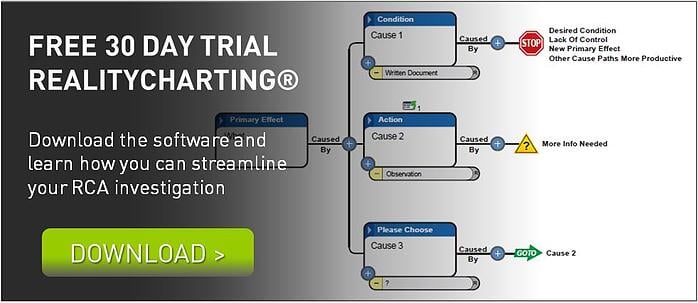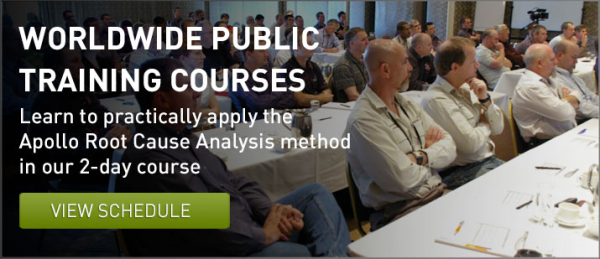By Jack Jager
We are all problem solvers. Each and every one of us actively deals with problems on a regular, if not a daily basis. However, the crucial question is “Is everyone actually good at problem solving?”
Quality of investigations vary and the trend appears to be a practical application of the normal curve. There are some fantastic results from investigations and also some poor results. But, if your organisation is seeing a whole pile of average investigations and average reports that result from them, then the effectiveness of your Investigation program can be improved.
Mediocrity occurs for a number of reasons. This article focuses on four aspects of your RCA program which, if not set up correctly, could be catalysts behind a consistent flow of mediocre root cause analysis investigations within your organization.
 1) A structure to support training
1) A structure to support training
So, you’ve trained your employees in root cause analysis and you’re expecting to see some fantastic RCA results coming through. Right?
…Not so fast.
If there is little structure to support the training in terms of:
- a requirement to use the process,
- mentoring and feedback provided to trainees,
- or quality audits on their efforts,
Then you can expect to see a whole range in terms of the quality of investigations being submitted. If the majority of the investigations are average then the value of the training comes into question.
This has often been the stimulus to look for different training in an alternative methodology because the perception is that the process selected for use by the company is not meeting expectations, it’s not working, people are not using it, and people don’t like it, or it’s not getting the results…..and so on.
If any training is unsupported, the same outcome could occur. So is this a problem with the training or a problem with the structure that supports the training?
Two days of training or a week of training doesn’t make anyone an expert in anything. Each trainee sits somewhere along the learning curve at the start of the training and hopefully, if they have been paying attention, they move along the curve to a better place after the training. The purpose of the training is to skew the curve – to move the curve to the right so you have more investigations being completed to a higher standard.
The challenge for all companies is to work out how to move trainees from where each
individual sits on that learning curve after the training, to application of excellence within the discipline at which the training was directed. Isn’t this what was originally intended?
For many individuals, this transition along the learning curve lacks clear structure and in many cases this structure simply does not exist. We train our people and then, figuratively speaking, throw them to the wolves expecting them to be the evangelists for the learning and the cure to all of our problems.
So what happens when we then get an average outcome? We don’t see the value in training more staff. And in this instance of problem solving, we will see a greater acceptance of mediocrity and of our inability to change this. It is essential that there is a feedback loop, whereby mediocre investigation reports are not accepted, or signed off.
Underpinning an effective investigation program requires managerial overview, whereby
managers are skilled in the RCA methodology and can challenge the outcome, provide positive recognition or insist on rework. If managers are not trained in the RCA method, then they are in the hands of the people who have been trained, and the danger is that mediocrity becomes the norm.
2) Amount of time dedicated to investigations
How long does an investigation take? Should it be one hour? Four hours? One day? One week?
There is no right answer.
If an investigation is warranted then it should be resourced to a point where an excellent result is possible. If that means you have 5 people in a room all day then so be it. The significance of the problem must warrant that level of support.
Conducting a root cause analysis requires a dedication of time and resources to achieve a
desirable outcome. How much do your problems cost you after all? If you want your investigations to be effective, then you will need to support them to the level needed. A clear understanding of the organisation’s threshold limits that determine the level of response, is essential to ensure appropriate allocation of resources and time to attend or complete an investigation.
When you find yourself in a rush, ask yourself if you are simply satisfying the need to report, completing obligatory requirements, just meeting deadlines or is there a genuine opportunity to improve the business and make a difference.
3) Involving the “right” people
If you don’t have the “right” people in the room – those with intimate knowledge or experience with the problem, then how good will the investigation will be?
Information is a key ingredient in all investigations and successful investigations require
that you have that information in the room in the form of the people who have the knowledge, data, evidence and reports.
Positive support and approval from management are necessary for people to be given the
time to attend the investigation.
4) Having the “right” facilitator
Do you have the “right” person facilitating?
Good communication skills are important, both verbal and non-verbal. A willingness to be the facilitator should also be considered…someone who has the desire to do this job.
A good facilitator should be impartial, unbiased, willing to ask the dumb question, and arguably should not be the subject matter expert. A great facilitator recognises that the credit for a good investigation outcome belongs to the team, and he works deliberately to facilitate that outcome.
In summary
The cost of significant incidents has a direct impact on the bottom line. Incidents can cost a company hundreds-of-thousands or even multi-million dollars. Every incident or accident that occurs is an opportunity to learn. If we can learn effectively by doing a high quality RCA, then the goal of trying to prevent their reoccurrence is far more likely to be achieved.
The best results occur from investigations that are well supported, have the right facilitator, and have the right people involved who have been given sufficient time to understand the event so they can present the best report possible.
Getting these elements right will go a long way towards moving the quality of your RCA investigations away from mediocrity and towards excellence.
A key factor in establishing the framework for an effective RCA program is a common application standard, and easy to use reporting, and charting tools. The Apollo Root Cause Analysis methodology has been used for over 20 years to support effective Problem Solving. RealityCharting™ software has been developed to provide standardisation, as well as quality checks and help. RC Coach is an online support tool with easy to access refresher training to help individuals to keep learning beyond the classroom.






